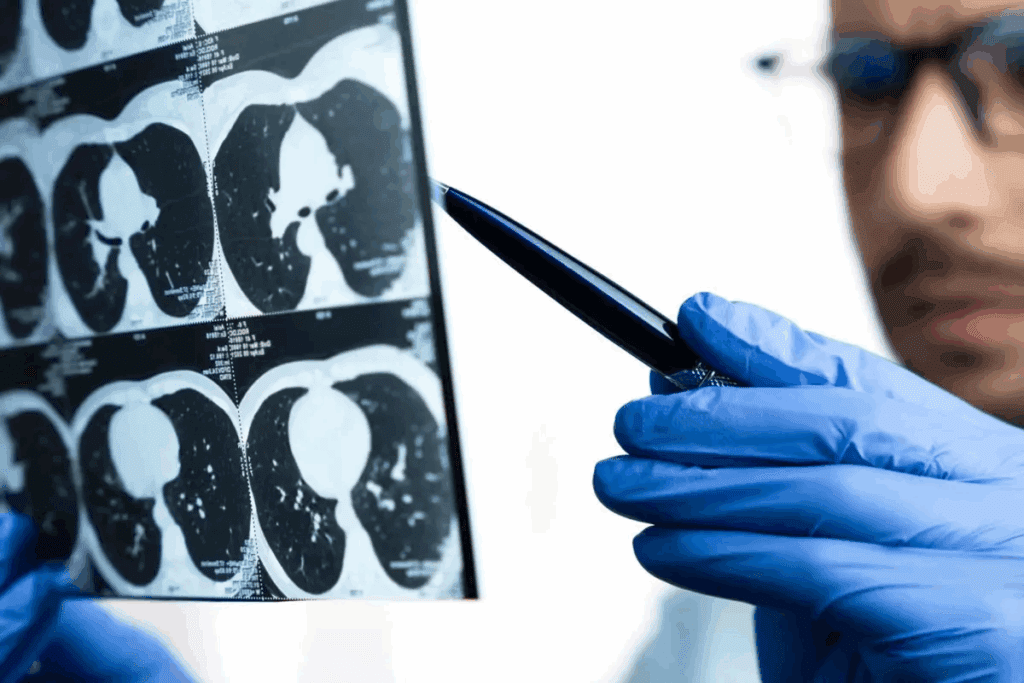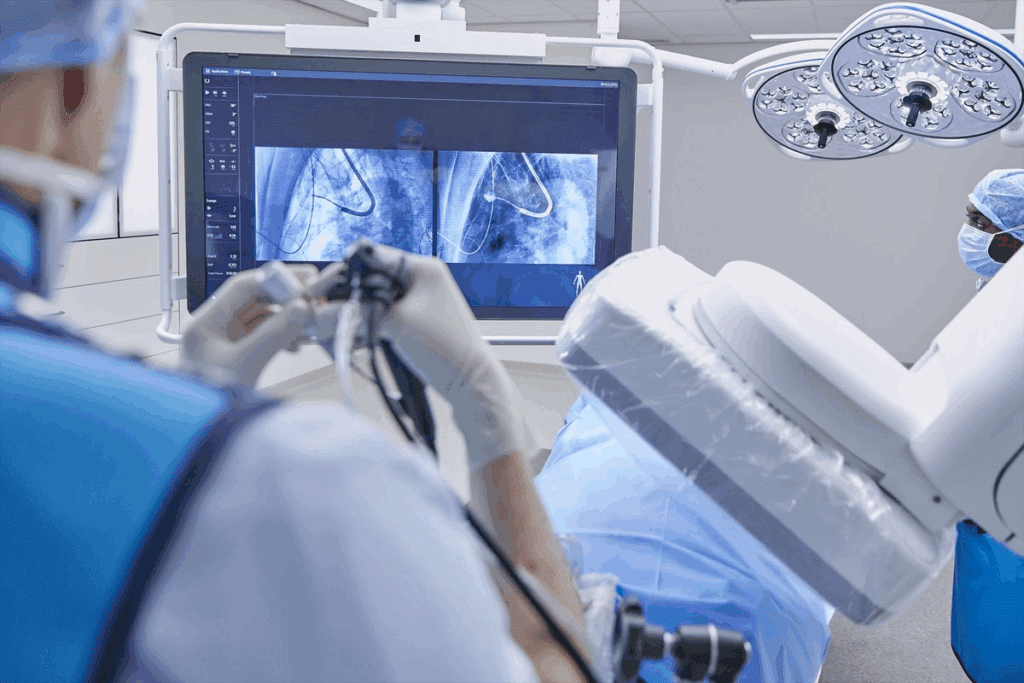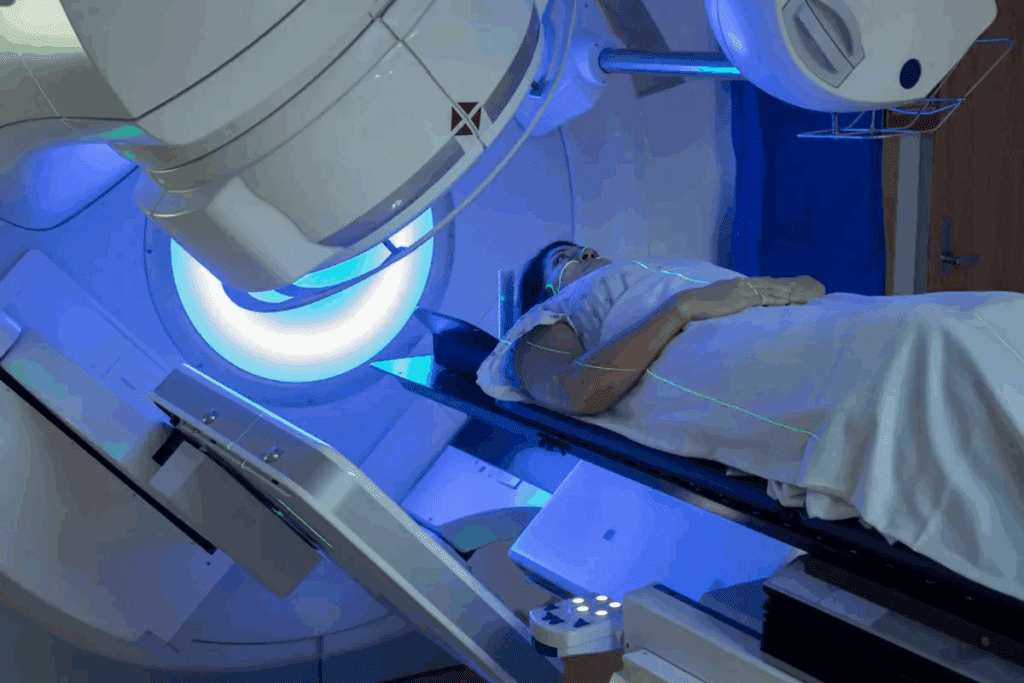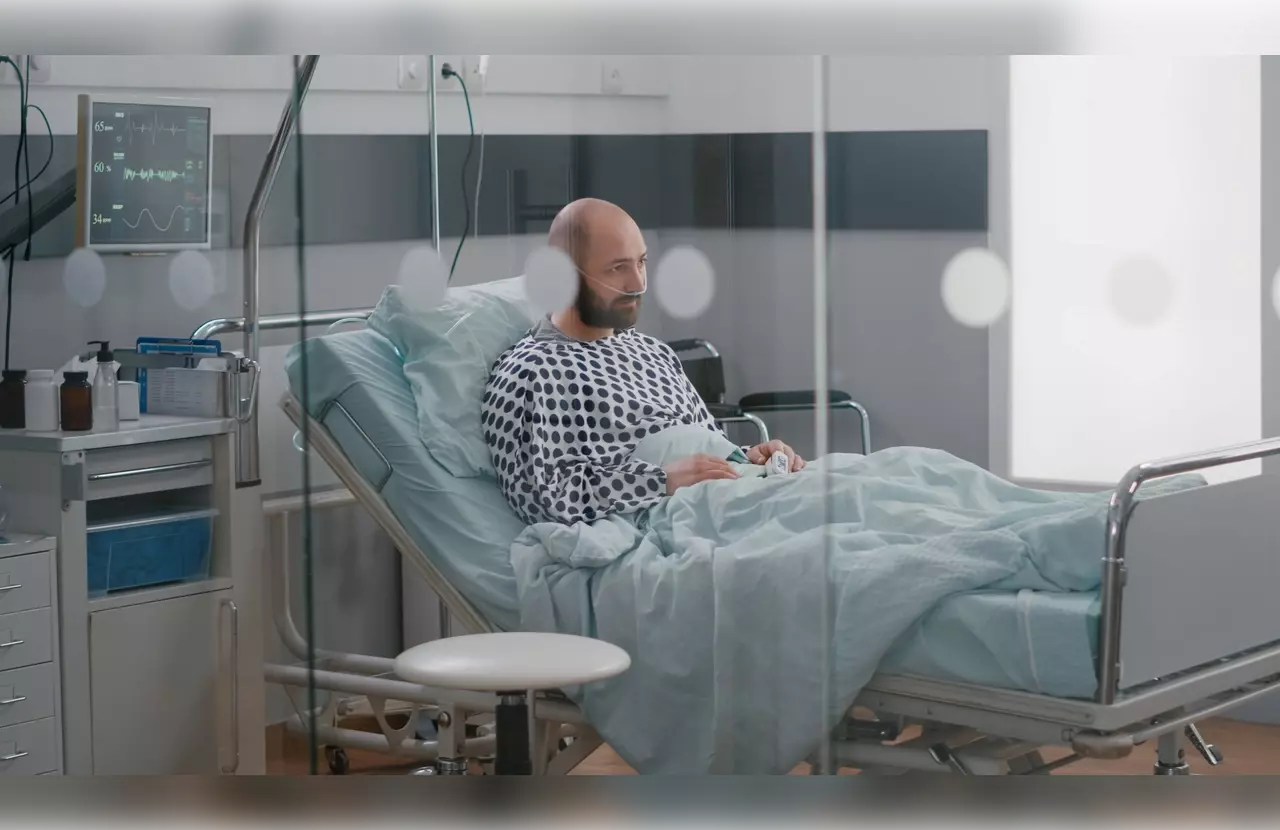Last Updated on November 26, 2025 by Bilal Hasdemir

Having a CT guided lung biopsy can worry patients a lot. At Liv Hospital, we focus on more than just the procedure. We aim to make your recovery smooth and safe.
Usually, patients stay for 1.5 to 3 hours after the biopsy. If they’re okay, they can go home the same day. But, how fast you recover depends on you. We use the best care and protocols to help you feel better.
Key Takeaways
- Most patients can go home the same day after a CT guided lung biopsy.
- The typical observation period is between 1.5 to 3 hours post-procedure.
- Individual factors, including complications, can influence recovery time.
- Liv Hospital prioritizes patient-centered care for a smooth recovery.
- Advanced medical protocols are used to optimize the recovery experience.
What Happens During a CT Guided Lung Biopsy

A CT guided lung biopsy is a precise medical procedure. It uses computed tomography to guide a needle into the lung tissue for sampling. This method targets the lung area of interest accurately, reducing the risk of complications.
The Procedure Process Explained
The CT guided lung biopsy procedure starts with the patient on a CT scanner table. They might be in a prone or supine position, depending on the lung lesion’s location. The area for the needle is cleaned and numbed with local anesthesia to reduce discomfort.
After preparation, the doctor guides the needle to the lung tissue using CT scans. The CT scanner shows real-time images. This allows the doctor to adjust the needle’s path for accurate placement.
“The use of CT guidance during lung biopsy has significantly improved the accuracy and safety of the procedure,” according to medical professionals.
Types of Needle Techniques Used
There are two main needle techniques in lung biopsy procedures: Fine Needle Aspiration (FNA) and Core Needle Biopsy (CNB). FNA uses a thin needle for cell samples. CNB uses a larger needle for a tissue core.
- FNA is used when the lesion is near vital structures, as it’s less invasive.
- CNB is chosen when a bigger tissue sample is needed for diagnosis.
What to Expect During the Procedure
During the CT guided lung biopsy, patients are closely watched, and it’s done under local anesthesia. The whole process takes about 30 to 60 minutes. But, the total time in the department might be longer due to preparation and recovery.
Patients might feel some pressure or discomfort when the needle is inserted. But, this is usually manageable. After the procedure, patients are observed for any immediate complications.
Knowing the steps of a CT guided lung biopsy can help reduce anxiety. It prepares patients for what to expect during and after the procedure.
CT Guided Lung Biopsy Recovery Time: What to Expect

Knowing how long it takes to recover from a CT guided lung biopsy is key. It helps patients get ready for the procedure and what to do after. The recovery starts right after the biopsy, with most patients staying in the hospital for a while.
Typical Hospital Observation Period (1.5-3 Hours)
Patients are watched in the hospital for 1.5 to 3 hours after the biopsy. This lets doctors check for any quick problems and help with pain. During this time, patients must stay calm and might be hooked up to machines to watch their health.
Same-Day Discharge Process
Many patients go home the same day as their biopsy. The discharge process includes:
- A final check by doctors to make sure everything is okay.
- Getting instructions on how to manage pain and what activities to avoid.
- Having someone to drive them home, as they might not be able to drive themselves.
It’s very important to follow these instructions to recover well.
Factors That May Extend Your Stay
Even though many patients go home the same day, some might stay longer. This can happen if:
- Complications like a collapsed lung or a lot of bleeding occur.
- Adverse reactions to the biopsy or medicines happen.
- Pre-existing conditions need more watching.
By understanding what to expect during recovery, patients can better prepare. This makes the recovery time more comfortable and safe.
Immediate Post-Procedure Effects
Knowing what to expect after a CT guided lung biopsy helps patients prepare for recovery. We help our patients understand what they might feel during this time.
Normal Symptoms After a Lung Biopsy
Patients might feel sore or uncomfortable at the biopsy site after the procedure. This is normal and usually goes away in a few days. Some might cough or feel short of breath, but these symptoms usually get better on their own.
It’s important to watch these symptoms and talk to your doctor if you have any worries. We suggest keeping a journal of your symptoms to track how you’re doing and catch any problems early.
Pain Management Expectations
Managing pain is key to a smooth recovery. We use different methods, like medicine and rest, to help with pain. Patients often get pain medicine to ease discomfort at the biopsy site.
| Pain Level | Recommended Action |
| Mild | Over-the-counter pain relievers |
| Moderate | Prescribed pain medication |
| Severe | Contact your healthcare provider immediately |
Initial Activity Restrictions
We advise avoiding hard activities for a few days after the biopsy. This means no heavy lifting, bending, or exercise. Rest and slowly get back to normal activities as you feel able.
Understanding these effects helps patients recover smoothly and avoid complications. Our team is here to help and support you every step of the way.
Common Complications That May Affect Recovery
Knowing about possible issues after a CT guided lung biopsy can ease worries. The procedure is usually safe, but knowing about risks can help. It makes recovery smoother.
Pneumothorax: Occurrence Rate and Management
Pneumothorax, or air in the pleural space, is a common issue. It happens in about 22 percent of cases. Most are mild and don’t need treatment.
Managing pneumothorax depends on its size. Small ones might just need watching. But bigger ones might need a chest tube to expand the lung.
Pulmonary Hemorrhage: Signs and Treatment
Pulmonary hemorrhage is less common but serious. It can cause coughing up blood or feeling like choking.
Treating pulmonary hemorrhage often means supportive care. This includes oxygen and, in severe cases, embolization to stop bleeding.
Infection: Risk Factors and Prevention
Infection is rare but serious. It’s more likely in those with lung disease or certain bacteria.
Preventing infection means using sterile methods and sometimes antibiotics.
Here’s a quick look at the complications and how to handle them:
| Complication | Occurrence Rate | Management |
| Pneumothorax | Approximately 22% | Monitoring, chest tube placement |
| Pulmonary Hemorrhage | Less common | Supportive care, embolization |
| Infection | Rare | Prophylactic antibiotics, sterile technique |
Understanding these complications and their treatment helps patients recover better from a CT guided lung biopsy.
The First 24 Hours After Your Lung Biopsy
The first 24 hours after your lung biopsy are key for a smooth recovery. It’s important to follow certain guidelines to stay safe and comfortable. We’ll guide you through the main points to focus on during this time.
Monitoring Your Breathing
Watching your breathing closely is a top priority after a lung biopsy. Keep an eye on your breathing rate and any breathing pattern changes. If you notice symptoms like shortness of breath, difficulty breathing, or worsening chest pain, get medical help right away.
- Shortness of breath
- Difficulty breathing
- Chest pain that worsens over time
Dr. Smith, a pulmonologist, says,
“Monitoring breathing is key as it can show signs of complications like pneumothorax.”
Make sure you can easily reach your healthcare provider if you notice any unusual symptoms.
Managing Discomfort and Pain
It’s normal to feel some discomfort or pain after a lung biopsy. Your healthcare provider will likely give you pain medication to help. It’s important to follow their advice and tell them about any severe or hard-to-manage pain.
To handle your discomfort well:
- Take your pain medication as directed
- Rest and avoid hard activities
- Use ice packs on the biopsy site if your doctor says it’s okay
Red Flags That Require Medical Attention
While some pain is okay, certain symptoms need immediate medical help. Be on the lookout for these red flags:
- Severe chest pain
- Coughing up blood
- Fever over 101.5°F (38.6°C)
- Getting more short of breath
If you see any of these signs, don’t wait to call your healthcare provider or go to the emergency room. Quick action can help avoid problems and make your recovery smoother.
By keeping an eye on your health and following these tips, you can get through the first 24 hours after your lung biopsy with confidence. Remember, your healthcare team is there to help you every step of the way.
Recovery Timeline: Day-by-Day Healing Process
Recovering from a lung biopsy is a step-by-step journey. It’s different for everyone, but most people see improvement in a few days to a week. We’ve outlined a typical recovery timeline in three phases to guide you.
Days 1-2: Initial Recovery Phase
Rest is key in the first couple of days. You might feel some pain or cough. Use the pain meds your doctor gave you and take it easy. Keep an eye on your breathing and watch for signs of trouble like severe chest pain or fever.
Days 3-7: Gradual Improvement
By day three, you’ll likely start feeling better. The pain should lessen, and you’ll have more energy. But, don’t lift heavy or do hard exercises yet. Keep an eye on your symptoms and follow your doctor’s advice.
Week 2 and Beyond: Complete Recovery
By the second week, you should be almost back to normal. You might feel a bit tired or sore, but that’s okay. Make sure to see your doctor as planned to check on the healing and discuss the biopsy results.
| Recovery Phase | Typical Symptoms | Recommended Care |
| Days 1-2 | Discomfort, pain, coughing | Rest, pain medication, monitor breathing |
| Days 3-7 | Gradual improvement, some pain | Avoid strenuous activities, follow post-procedure care |
| Week 2 and Beyond | Mild fatigue, discomfort | Follow-up with healthcare provider, resume normal activities gradually |
Knowing the recovery timeline helps you plan and spot any problems early. Always talk to your doctor for specific advice and care.
Comparing IR Biopsy Recovery to Other Lung Biopsy Methods
The recovery time can change a lot based on the lung biopsy type. IR biopsy is often the least invasive. Knowing these differences helps patients set realistic expectations and choose the best care for themselves.
CT Scan vs. Cat Scan Guided Lung Biopsy Recovery
CT scan and Cat Scan guided lung biopsies are the same thing. “Cat Scan” is just an old term for CT scan. Most people get discharged the same day after a CT scan guided lung biopsy. This is because CT scans help place the needle exactly right, causing less damage and quicker healing.
Key benefits of CT scan guided biopsy recovery include:
- Minimally invasive with small incisions
- Reduced risk of complications
- Faster recovery times compared to surgical biopsies
Interventional Radiology (IR) Biopsy Advantages
IR biopsy has many benefits over other methods. It uses advanced imaging for real-time guidance. This means the biopsy is more precise, leading to a quicker and more comfortable recovery for patients.
The benefits of IR biopsy include:
- High precision in targeting the biopsy site
- Minimally invasive, reducing tissue trauma
- Lower risk of complications
- Faster recovery times
Recovery Differences Between Needle and Surgical Biopsies
Needle biopsies, like IR and CT scan guided ones, have a big difference in recovery compared to surgical biopsies. Surgical biopsies need bigger cuts and cause more damage, leading to longer healing times.
| Biopsy Type | Typical Recovery Time | Level of Invasiveness |
| Needle Biopsy (IR or CT guided) | Same day or 1-2 days | Minimally invasive |
| Surgical Biopsy | Several days to weeks | More invasive |
Knowing these differences helps patients get ready for their recovery. It also helps them make better choices about their diagnostic care.
Special Considerations for Lung Mediastinum Biopsies
Lung mediastinum biopsies need special care because of their location. The mediastinum is in the chest and has important parts like the heart and blood vessels. It’s vital to plan and do these biopsies carefully to avoid risks and help with recovery.
Why Mediastinum Biopsies Have Different Recovery Needs
Biopsies in the mediastinum are tricky because of the area’s complexity. The heart and big blood vessels are close, which raises the chance of bleeding or heart problems. Getting tissue samples without harming nearby tissues is also hard.
Proximity to Critical Structures and Recovery Impact
The biopsy site’s closeness to vital organs affects recovery. Patients might feel more pain because of the area’s sensitivity. There’s also a higher chance of complications like a collapsed lung or bleeding, which can make recovery longer. So, it’s important to watch patients closely after the procedure to catch and treat any problems quickly.
Specific Post-Procedure Care Instructions
Patients need to follow certain steps to recover well from a lung mediastinum biopsy. These include:
- Watching for signs of complications like trouble breathing, severe chest pain, or fever.
- Using medicine and resting to manage pain.
- Not doing too much for a while.
- Going to follow-up appointments as scheduled to check on the biopsy site and recovery.
| Care Instruction | Description | Importance Level |
| Monitor for Complications | Watch for signs of difficulty breathing, severe pain, or fever. | High |
| Pain Management | Use prescribed medication to manage discomfort. | High |
| Activity Restriction | Avoid strenuous activities for the recommended period. | Medium |
| Follow-Up Care | Attend scheduled follow-up appointments. | High |
Understanding the special needs of lung mediastinum biopsies and following care instructions can help patients recover better. This way, they can avoid complications and have a smoother recovery.
Adrenal Gland Biopsy Recovery Specifics
Knowing how to recover from an adrenal gland biopsy is key. It helps you feel better and get back to normal life. When you have a biopsy of the adrenal gland, knowing what to expect can help you take care of yourself.
Typical Recovery Timeline for Adrenal Procedures
The time it takes to recover from an adrenal gland biopsy can differ. It depends on your health and if any problems arise. Usually, people can start doing normal things again in a few days to a week.
Here’s what you might go through during recovery:
| Timeframe | Expected Recovery Progress |
| First 24 hours | Rest and observation; possible soreness or discomfort at the biopsy site |
| 2-3 days | Gradual improvement; possible return to light activities |
| 1 week | Most patients can resume normal activities; follow-up appointment with doctor |
Unique Considerations for Biopsy of Adrenal Gland
Adrenal gland biopsies are usually done with CT guidance. This means a needle is inserted through the skin to get tissue samples. It’s important to watch for any issues after the procedure.
Monitoring Requirements After the Procedure
After an adrenal gland biopsy, you’ll be watched for a few hours. This is to catch any immediate problems like bleeding or pneumothorax. It’s vital to follow your doctor’s advice on how to care for yourself after the biopsy.
- Monitoring the biopsy site for signs of infection or bleeding
- Managing pain or discomfort as directed by your healthcare provider
- Avoiding strenuous activities for a specified period
By understanding biopsy adrenal gland recovery, you can handle your care better. This helps avoid any extra risks.
7 Practical Tips for Faster Recovery After Lung Biopsy
To recover quickly after a lung biopsy, follow these important tips. They will help you get through the post-procedure period with ease. Healing from a lung biopsy is not just about physical recovery. It also means adopting habits that boost your overall health.
Tip 1: Optimal Hydration and Nutrition
Drinking plenty of water is key for healing. Also, eat foods that are easy to digest and full of nutrients. A balanced diet helps fix tissues and keeps your immune system strong. Make sure to include foods rich in protein, vitamins, and minerals in your meals.
Tip 2: Effective Breathing Exercises
Breathing exercises are great for recovery. They help improve lung function and lower the chance of problems. Start with gentle deep breathing exercises and slowly increase the time as you get better.
Tip 3: Proper Wound Care
Good wound care is essential to avoid infection and ensure a smooth recovery. Keep the biopsy site clean and dry, and follow any specific instructions from your healthcare team. Watch the wound for signs of infection, like redness, swelling, or discharge.
Tip 4: Gradual Activity Resumption
Starting with light activities and gradually increasing them is important for recovery. Begin with simple tasks like walking and gradually do more based on how you feel. Avoid hard activities and heavy lifting for the time your doctor advises.
By following these tips, you can improve your recovery and reduce risks. Remember, your healthcare team is there to help you every step of the way.
When to Contact Your Doctor During Recovery from Lung Biopsy
Knowing when to get medical help after a lung biopsy is key to your health. After a CT-guided lung biopsy, some discomfort is normal. But, some symptoms can mean serious problems that need quick doctor visits.
Warning Signs That Require Immediate Attention
While you’re recovering from a lung biopsy, watch your body closely. If you have any of these severe symptoms, get help right away:
- Severe chest pain or trouble breathing
- Coughing up blood or rust-colored mucus
- Fever over 101.5°F (38.6°C)
- Increasing redness, swelling, or drainage from the biopsy site
- Dizziness or fainting
Distinguishing Normal Discomfort from Complications
Telling normal discomfort from complications can be tricky. Mild pain, a slight cough, and some discomfort at the biopsy site are okay. But, if these get worse or come with other bad signs, call your doctor.
Here’s a table to help you tell the difference:
| Symptom | Normal | Concerning |
| Pain | Mild, manageable with medication | Severe, worsening, or unresponsive to medication |
| Cough | Slight, dry cough | Producing blood or thick mucus |
| Fever | Less than 100.4°F (38°C) | Above 101.5°F (38.6°C) or persistent |
Questions to Ask at Your Follow-Up Appointment
Your follow-up appointment is a chance to talk about any worries or questions. You might ask:
“What are the expected findings from my biopsy, and how will they impact my treatment plan?”
- How long should I expect to feel the effects of the biopsy?
- Are there any specific activities I should avoid during the recovery period?
- What are the signs of possible complications that I should watch for?
Conclusion: Navigating Your CT Guided Lung Biopsy Recovery
Recovering from a CT guided lung biopsy needs careful attention and understanding. Most people can get better with the right care. Follow the post-procedure instructions from your healthcare team to avoid complications and ensure a good recovery.
Knowing what to expect during ct guided lung biopsy recovery and watching for signs of trouble can ease worries. Lung biopsy recovery is usually straightforward. But, it’s important to watch your health and get medical help if you notice anything odd.
Being informed and proactive helps you feel confident during your recovery from lung biopsy. Always follow your healthcare provider’s advice for the best results.
FAQ
What is the typical recovery time for a CT guided lung biopsy?
Most patients can go home the same day. They usually stay in the hospital for 1.5-3 hours. It takes a few days to a week to get back to normal activities.
What are the common symptoms after a CT guided lung biopsy?
You might feel discomfort, pain, or have trouble breathing. We give tips on managing these symptoms.
What are the possible complications of a CT guided lung biopsy?
Complications include pneumothorax, pulmonary hemorrhage, and infection. We explain how common these are and how to manage them.
How do I manage discomfort and pain after the procedure?
We offer advice on managing pain and discomfort during recovery.
What are the warning signs that require immediate medical attention during recovery?
We list warning signs like severe breathing trouble, chest pain, or infection. Knowing these signs is important.
How can I enhance my recovery after a lung biopsy?
We share tips on staying hydrated, eating well, breathing exercises, wound care, and gradually getting active again.
What is the difference in recovery between needle and surgical biopsies?
We compare recovery times for needle and surgical biopsies. We highlight the benefits of each.
Are there special considerations for lung mediastinum biopsies?
Yes, lung mediastinum biopsies need special care due to their location. We provide specific instructions for these biopsies.
What is the typical recovery timeline for an adrenal gland biopsy?
We discuss the recovery time and special considerations for adrenal gland biopsies. We also talk about monitoring after the procedure.
How long does it take to recover from a CT guided lung biopsy?
Recovery time varies, but most people can get back to normal in a few days to a week. We provide a detailed timeline to guide you.
What are the advantages of IR biopsy compared to other lung biopsy methods?
IR biopsy is less invasive and might have a faster recovery than surgical biopsies. We discuss its benefits.
References
Peng, J., et al. (2024). Systematic review and meta-analysis of current evidence in uterine artery embolization compared to myomectomy on symptomatic uterine fibroids. Scientific Reports, 14, Article 12345. https://www.nature.com/articles/s41598-024-69754-0






